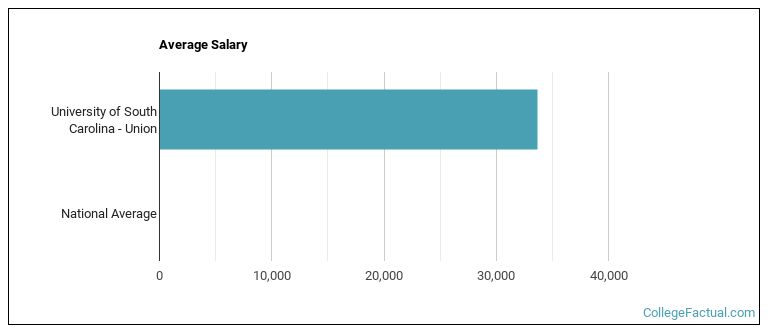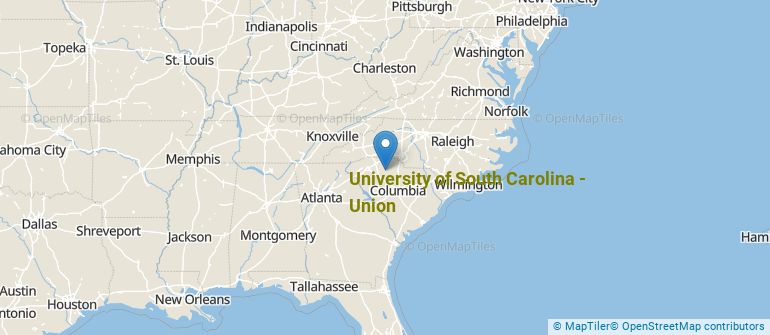 by our College Data Analytics Team
by our College Data Analytics TeamExplore the best ranked schools for the programs you are most interested in.
USC Union is ranked #1,993 out of 2,152 schools in the nation for overall quality on College Factual's 2025 Best Colleges list. This is an improvement over the previous year, when USC Union held the #2,149 spot on the Best Overall Colleges list.
USC Union also holds the #40 spot on the Best Colleges in South Carolina ranking.
See all of the rankings for University of South Carolina - Union.
The acceptance rate at University of South Carolina - Union is 80%. That's higher than the rate at many schools, but still low enough to be considered somewhat selective. If you want to get in, you'll need good grades and to be able to show that USC Union is a good fit for you.
The student to faculty ratio at University of South Carolina - Union is about average at 15 to 1. This ratio is often used to gauge how many students might be in an average class and how much time professors will have to spend with their students on an individual level. The national average for this metric is 15 to 1.
Another measure that is often used to estimate how much access students will have to their professors is how many faculty members are full-time. The idea here is that part-time faculty tend to spend less time on campus, so they may not be as available to students as full-timers.
The full-time faculty percentage at University of South Carolina - Union is 28%. This is lower than the national average of 47%.
The freshmen retention rate is a sign of how many full-time students like a college or university well enough to come back for their sophomore year. At University of South Carolina - Union this rate is 52%, which is a bit lower than the national average of 68%.
During the 2017-2018 academic year, there were 1,071 undergraduates at USC Union with 324 being full-time and 747 being part-time.
| $0-30 K | $30K-48K | $48-75 | $75-110K | $110K + |
|---|---|---|---|---|
| $8,510 | $9,695 | $12,746 | $15,432 | $15,979 |
The net price is calculated by adding tuition, room, board and other costs and subtracting financial aid.Note that the net price is typically less than the published for a school. For more information on the sticker price of USC Union, see our tuition and fees and room and board pages.
It's not uncommon for college students to take out loans to pay for school. In fact, almost 66% of students nationwide depend at least partially on loans. At USC Union, approximately 41% of students took out student loans averaging $5,565 a year. That adds up to $22,260 over four years for those students.
Get more details about paying for University of South Carolina - Union.

See which majors at University of South Carolina - Union make the most money.
Get more details about the location of University of South Carolina - Union.

Contact details for USC Union are given below.
| Contact Details | |
|---|---|
| Address: | 309 East Academy St, Union, SC 29379-0729 |
| Phone: | 864-429-8728 |
| Website: | www.sc.edu/about/system_and_campuses/union/index.php |
| Most Popular Majors | Bachelor’s Degrees | Average Salary of Graduates |
|---|---|---|
| Liberal Arts General Studies | 97 | NA |
Online learning is becoming popular at even the oldest colleges and universities in the United States. Not only are online classes great for returning adults with busy schedules, they are also frequented by a growing number of traditional students.
In 2022-2023, 650 students took at least one online class at University of South Carolina - Union. This is a decrease from the 749 students who took online classes the previous year.
| Year | Took at Least One Online Class | Took All Classes Online |
|---|---|---|
| 2022-2023 | 650 | 253 |
| 2021-2022 | 749 | 158 |
| 2020-2021 | 927 | 454 |
| 2018-2019 | 11 | 0 |
Learn more about online learning at University of South Carolina - Union.
Footnotes
*The racial-ethnic minorities count is calculated by taking the total number of students and subtracting white students, international students, and students whose race/ethnicity was unknown. This number is then divided by the total number of students at the school to obtain the racial-ethnic minorities percentage.
References
More about our data sources and methodologies.